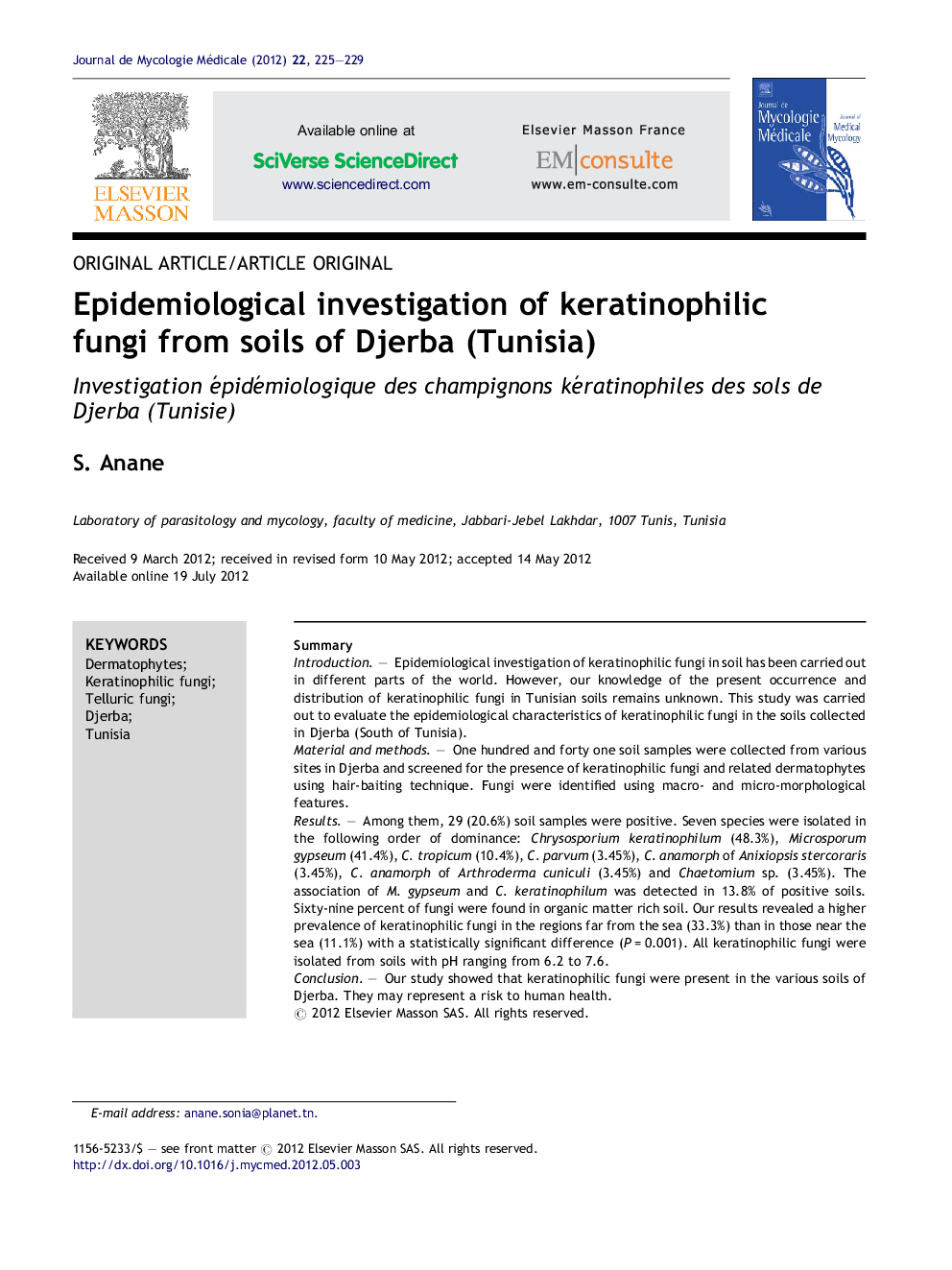| کد مقاله | کد نشریه | سال انتشار | مقاله انگلیسی | نسخه تمام متن |
|---|---|---|---|---|
| 3219909 | 1204458 | 2012 | 5 صفحه PDF | دانلود رایگان |

SummaryIntroductionEpidemiological investigation of keratinophilic fungi in soil has been carried out in different parts of the world. However, our knowledge of the present occurrence and distribution of keratinophilic fungi in Tunisian soils remains unknown. This study was carried out to evaluate the epidemiological characteristics of keratinophilic fungi in the soils collected in Djerba (South of Tunisia).Material and methodsOne hundred and forty one soil samples were collected from various sites in Djerba and screened for the presence of keratinophilic fungi and related dermatophytes using hair-baiting technique. Fungi were identified using macro- and micro-morphological features.ResultsAmong them, 29 (20.6%) soil samples were positive. Seven species were isolated in the following order of dominance: Chrysosporium keratinophilum (48.3%), Microsporum gypseum (41.4%), C. tropicum (10.4%), C. parvum (3.45%), C. anamorph of Anixiopsis stercoraris (3.45%), C. anamorph of Arthroderma cuniculi (3.45%) and Chaetomium sp. (3.45%). The association of M. gypseum and C. keratinophilum was detected in 13.8% of positive soils. Sixty-nine percent of fungi were found in organic matter rich soil. Our results revealed a higher prevalence of keratinophilic fungi in the regions far from the sea (33.3%) than in those near the sea (11.1%) with a statistically significant difference (P = 0.001). All keratinophilic fungi were isolated from soils with pH ranging from 6.2 to 7.6.ConclusionOur study showed that keratinophilic fungi were present in the various soils of Djerba. They may represent a risk to human health.
RésuméIntroductionL’investigation épidémiologique des champignons kératinophiles dans le sol a été réalisée partout dans le monde. Cependant, notre connaissance sur l’incidence et la répartition de ces champignons en Tunisie reste mal connue. Ce travail a été effectué afin d’évaluer les caractéristiques épidémiologiques des champignons kératinophiles isolés au niveau des sols sélectionnés de Djerba (sud de la Tunisie).Matériel et méthodesCent quarante et un échantillons de sols ont été collectés à partir des différents sites sélectionnés de Djerba. Pour isoler les dermatophytes et les champignons kératinophiles, la technique d’appâtage à la kératine a été appliquée. L’identification des champignons a été basée sur l’examen macroscopique et microscopique des cultures.RésultatsVingt-neuf échantillons (20,6 %) de sol ont été positifs. Sept espèces ont été isolées : Chrysosporium keratinophilum (48,3 %), Microsporum gypseum (41,4 %), C. tropicum (10,3 %), C. parvum (3,45 %), C. anamorph de Anixiopsis stercoraris (3,45 %), C. anamorph de Arthroderma cuniculi (3,45 %) et Chaetomium sp. (3,45 %). L’association de M. gypseum au C. keratinophilum a été notée dans 13,8 % des sols positifs. Soixante-neuf pour cent des champignons ont été isolés au niveau des sols riches en matière organique. Nos résultats ont montré une prévalence des champignons kératinophiles plus élevée dans les régions loin de la mer (33,3 %) que dans celles proches de la mer (11,1 %) avec une différence statistiquement significative (p = 0,001). Tous les champignons kératinophiles ont été isolés sur des sols ayant un pH compris entre 6,2 et 7,6.ConclusionNotre étude a montré la présence des champignons kératinophiles au niveau des différents sols de Djerba. Leur présence dans le sol peut représenter un risque pour la santé humaine.
Journal: Journal de Mycologie Médicale / Journal of Medical Mycology - Volume 22, Issue 3, September 2012, Pages 225–229